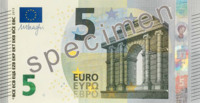5 euro note
| (Eurozone and Institutions) | |
|---|---|
| Value | 5 euro |
| Width | 120 mm |
| Height | 62 mm |
| Security features |
First series: hologram stripe with perforations, reflective glossy stripe, EURion constellation, watermarks, raised printing, microprinting, ultraviolet ink, security thread, matted surface, see-through number, barcodes and serial number |
| Paper type | Cotton fibre |
| Years of printing | 1999 - 2011 (1st series) Since 2012 (Europa series) |
| Obverse | |
 |
|
| Design | Arch in Classical architecture |
| Designer | Reinhold Gerstetter |
| Design date | 10 January 2013 |
| Reverse | |
 |
|
| Design | Bridge in Classical architecture and map of Europe |
| Designer | Reinhold Gerstetter |
| Design date | 10 January 2013 |
First series: hologram stripe with perforations, reflective glossy stripe, EURion constellation, watermarks, raised printing, microprinting, ultraviolet ink, security thread, matted surface, see-through number, barcodes and serial number
The five euro note (€5) is the lowest value euro banknote and has been used since the introduction of the euro (in its cash form) in 2002. The note is used in the 25 countries which have it as their sole currency (with 23 legally adopting it); with a population of about 332 million.
Measuring 120 x 62mm, it is the smallest of the euro notes, and has a grey colour scheme. The five euro banknotes depict bridges and arches/doorways in Classical architecture (up to the fifth century).
The five euro note contains several complex security features such as watermarks, invisible ink, holograms and microprinting that document its authenticity. In November 2014, there were approximately 1,653,458,000 five euro banknotes in circulation around the eurozone.
On 8 November 2012, the European Central Bank announced the first series of notes will be replaced, starting with the 5 euro note on 2 May 2013.
The euro was founded on 1 January 1999, when it became the currency of over 300 million people in Europe. For the first three years of its existence it was an invisible currency, only used in accountancy. Euro cash was not introduced until 1 January 2002, when it replaced the national banknotes and coins of the countries in eurozone 12, such as the Irish pound and the Austrian schilling.
Slovenia joined the Eurozone in 2007,Cyprus and Malta in 2008,Slovakia in 2009,Estonia in 2011 and Latvia on 1 January 2014.
...
Wikipedia
